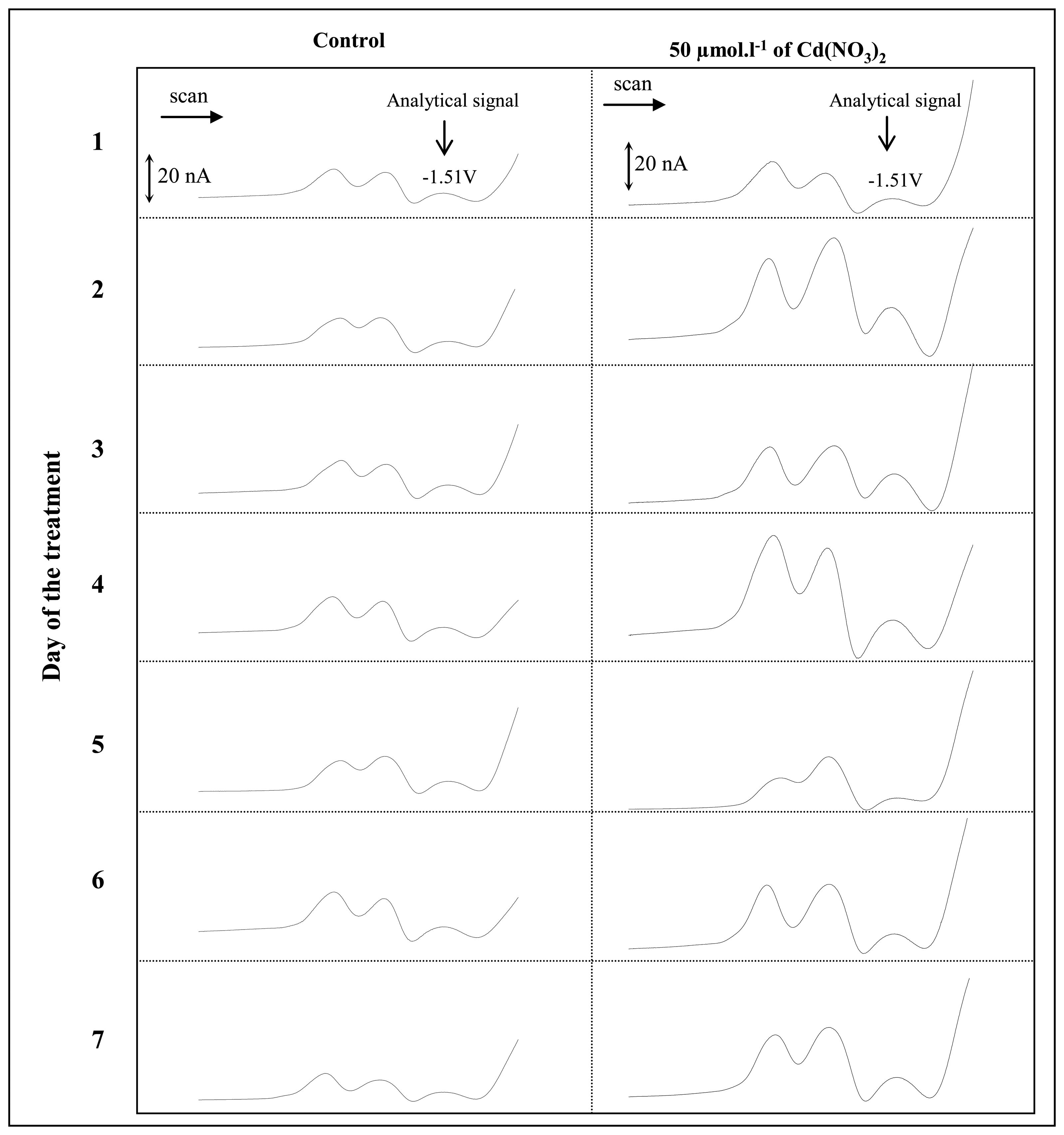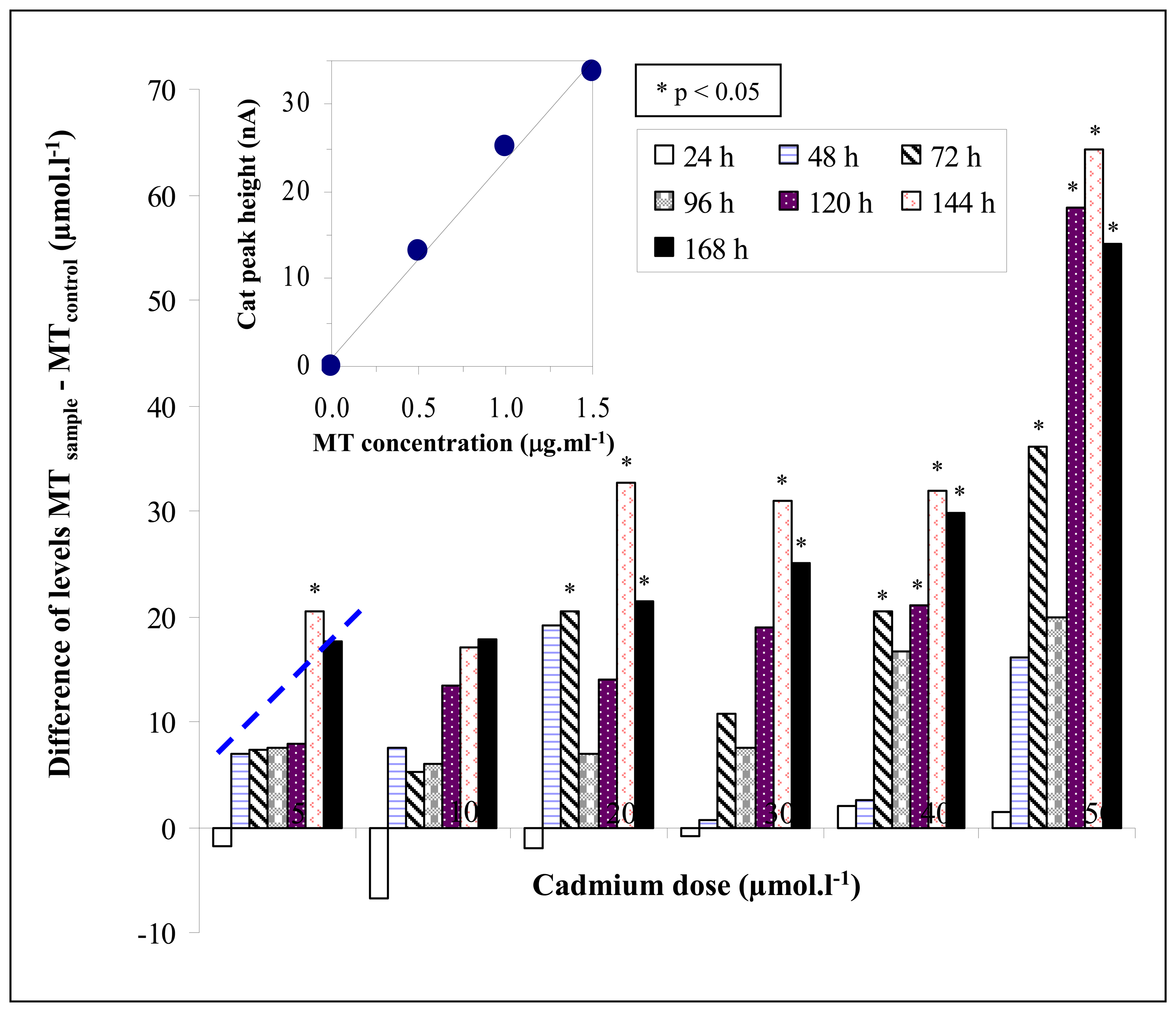Influence of Cadmium(II) Ions and Brewery Sludge on Metallothionein Level in Earthworms (Eisenia fetida) – Bio- transforming of Toxic Wastes
Abstract
:1. Introduction
2. Material and Methods
2.1 Chemicals and pH measurements
2.2 Biological samples
2.3 Preparation of biological samples for electrochemical analysis
2.4 Electrochemical measurements
2.5 Statistical analysis
3. Results and Discussion
3.1 Changes in metallothionein level in earthworms exposed to cadmium ions
3.2 Influence of the brewery sludge and/or its leach on earthworms
4. Conclusion
Acknowledgments
References
- Ma, W.C. Estimating heavy metal accumulation in oligochaete earthworms: A meta-analysis of field data. Bull. Environ. Contam. Toxicol. 2004, 72, 663–670. [Google Scholar]
- Booth, L.H.; Hodge, S.; O'Halloran, K. Use of biomarkers in earthworms to detect use and abuse of field applications of a model organophosphate pesticide. Bull. Environ. Contam. Toxicol. 2001, 67, 633–640. [Google Scholar]
- Ramos, L.; Fernandez, M.A.; Gonzalez, M.J.; Hernandez, L.M. Heavy metal pollution in water, sediments, and earthworms from the Ebro River, Spain. Bull. Environ. Contam. Toxicol. 1999, 63, 305–311. [Google Scholar]
- Fitzpatrick, L.C.; MurattiOrtiz, J.F.; Venables, B.J.; Goven, A.J. Comparative toxicity in earthworms Eisenia fetida and Lumbricus terrestris exposed to cadmium nitrate using artificial soil and filter paper protocols. Bull. Environ. Contam. Toxicol. 1996, 57, 63–68. [Google Scholar]
- Aira, M.; Monroy, F.; Dominguez, J. Changes in microbial biomass and microbial activity of pig slurry after the transit through the gut of the earthworm Eudrilus eugeniae (Kinberg, 1867). Biol. Fertil. Soils 2006, 42, 371–376. [Google Scholar]
- Unwin, R.J.; Lewis, S. The Effect Upon Earthworm Populations of Very Large Applications of Pig Slurry to Grassland. Agricult. Wastes 1986, 16, 67–73. [Google Scholar]
- Debry, J.M.; Houssiau, M.; Lemassonflorenville, M.; Wauthy, G.; Lebrun, P. Impact of Introduced Earthworm Populations on Ph and Nitrogen Dynamics in Soils Treated with Pig Slurry. Pedobiologia 1982, 23, 157–171. [Google Scholar]
- Marijic, V.F.; Raspor, B. Age- and tissue-dependent metallothionein and cytosolic metal distribution in a native Mediterranean fish, Mullus barbatus, from the Eastern Adriatic Sea. Comp. Biochem. Physiol. C-Toxicol. Pharmacol. 2006, 143, 382–387. [Google Scholar]
- Dragun, Z.; Raspor, B.; Erk, M.; Ivankovic, D.; Pavicic, J. The influence of the biometric parameters on metallothionein and metal level in the heat-treated cytosol of the whole soft tissue of transplanted mussels. Environ. Monit. Assess. 2006, 114, 49–64. [Google Scholar]
- Kagi, J.G.R.; Schaffer, A. Biochemistry of Metallothionein. Biochemistry 1988, 27, 8509–8515. [Google Scholar]
- Kizek, R.; Trnkova, L.; Palecek, E. Determination of metallothionein at the femtomole level by constant current stripping chronopotentiometry. Anal. Chem. 2001, 73, 4801–4807. [Google Scholar]
- Trnkova, L.; Kizek, R.; Vacek, J. Catalytic signal of rabbit liver metallothionein on a mercury electrode: a combination of derivative chronopotentiometry with adsorptive transfer stripping. Bioelectrochemistry 2002, 56, 57–61. [Google Scholar]
- Nordberg, M.; Nordberg, G.F. Toxicological aspects of metallothionein. Cell. Mol. Biol. 2000, 46, 451–463. [Google Scholar]
- Strouhal, M.; Kizek, R.; Vacek, J.; Trnkova, L.; Nemec, M. Electrochemical study of heavy metals and metallothionein in yeast Yarrowia lipolytica. Bioelectrochemistry 2003, 60, 29–36. [Google Scholar]
- Adam, V.; Petrlova, J.; Potesil, D.; Zehnalek, J.; Sures, B.; Trnkova, L.; Jelen, F.; Kizek, R. Study of metallothionein modified electrode surface behavior in the presence of heavy metal ions-biosensor. Electroanalysis 2005, 17, 1649–1657. [Google Scholar]
- Wu, S.M.; Jong, K.J.; Lee, Y.J. Relationships among metallothionein, cadmium accumulation, and cadmium tolerance in three species of fish. Bull. Environ. Contam. Toxicol. 2006, 76, 595–600. [Google Scholar]
- Eroglu, K.; Atli, G.; Canli, M. Effects of metal (Cd, Cu, Zn) interactions on the profiles of metallothionein-like proteins in the nile fish Oreochromis niloticus. Bull. Environ. Contam. Toxicol. 2005, 75, 390–399. [Google Scholar]
- Martins, N.; Lopes, I.; Guilhermino, L.; Bebianno, M.J.; Ribeiro, R. Lack of evidence for metallothionein role in tolerance to copper by natural populations of Daphnia longispina. Bull. Environ. Contam. Toxicol. 2005, 74, 761–768. [Google Scholar]
- Rovira, M.S.; Fernandez-Diaz, C.; Canavate, J.P.; Blasco, J. Effects on metallothionein levels and other stress defences in Senegal sole larvae exposed to cadmium. Bull. Environ. Contam. Toxicol. 2005, 74, 597–603. [Google Scholar]
- Kizek, R.; Vacek, J.; Trnkova, L.; Jelen, F. Cyclic voltammetric study of the redox system of glutathione using the disulfide bond reductant tris(2-carboxyethyl)phosphine. Bioelectrochemistry 2004, 63, 19–24. [Google Scholar]
- Petrlova, J.; Potesil, D.; Mikelova, R.; Blastik, O.; Adam, V.; Trnkova, L.; Jelen, F.; Prusa, R.; Kukacka, J.; Kizek, R. Attomole voltammetric determination of metallothionein. Electrochim. Acta 2006, 51, 5112–5119. [Google Scholar]
- Adam, V.; Blastik, O.; Krizkova, S.; Lubal, P.; Kukacka, J.; Prusa, R.; Kizek, R. Application of the Brdicka reaction in determination of metallothionein in patients with tumours. Chem. Listy 2008, 102, 51–58. [Google Scholar]
- Krizkova, S.; Zitka, O.; Adam, V.; Beklova, M.; Horna, A.; Svobodova, Z.; Sures, B.; Trnkova, L.; Zeman, L.; Kizek, R. Possibilities of electrochemical techniques in metallothionein and lead detection in fish tissues. Czech J. Anim. Sci. 2007, 52, 143–148. [Google Scholar]
- Petrlova, J.; Krizkova, S.; Zitka, O.; Hubalek, J.; Prusa, R.; Adam, V.; Wang, J.; Beklova, M.; Sures, B.; Kizek, R. Utilizing a chronopotentiometric sensor technique for metallothionein determination in fish tissues and their host parasites. Sens. Actuator B-Chem. 2007, 127, 112–119. [Google Scholar]
- Yamamura, M.; Mori, T.; Suzuki, K.T. Metallothionein Induced in the Earthworm. Experientia 1981, 37, 1187–1189. [Google Scholar]
- Morgan, A.J.; Sturzenbaum, S.R.; Winters, C.; Grime, G.W.; Abd Aziz, N.A.; Kille, P. Differential metallothionein expression in earthworm (Lumbricus rubellus) tissues. Ecotox. Environ. Safe. 2004, 57, 11–19. [Google Scholar]
- Homa, J.; Olchawa, E.; Sturzenbaum, S.R.; Morgan, A.J.; Plytycz, B. Early-phase immunodetection of metallothionein and heat shock proteins in extruded earthworm coelomocytes after dermal exposure to metal ions. Environ. Pollut. 2005, 135, 275–280. [Google Scholar]
- Sturzenbaum, S.R.; Kille, P.; Morgan, A.J. The identification, cloning and characterization of earthworm metallothionein. FEBS Lett. 1998, 431, 437–442. [Google Scholar]
- Langdon, C.J.; Winters, C.; Sturzenbaum, S.R.; Morgan, A.J.; Charnock, J.M.; Meharg, A.A.; Piearce, T.G.; Lee, P.H.; Semple, K.T. Ligand arsenic complexation and immunoperoxidase detection of metallothionein in the earthworm Lumbricus rubellus inhabiting arsenic-rich soil. Environ. Sci. Technol. 2005, 39, 2042–2048. [Google Scholar]
- Prusa, R.; Petrlova, J.; Kukacka, J.; Adam, V.; Sures, B.; Beklova, M.; Kizek, R. Study of interaction of glutathiones and metallothionein with cytostatics. Clin. Chem. 2006, 52, A175–A175. [Google Scholar]
- Adam, V.; Beklova, M.; Pikula, J.; Hubalek, J.; Trnkova, L.; Kizek, R. Shapes of differential pulse voltammograms and level of metallothionein at different animal species. Sensors 2007, 7, 2419–2429. [Google Scholar]


| Applied concentration of Cd(NO3)2(μmol.l−1) | Mean concentration of MTa,b(μmol.l−1) | Standard deviationa,b | Concentration of MTa,b Maximum Minimum (μmol.l−1) | |
|---|---|---|---|---|
| 0 | 31.6 | 10.3 | 48.5 | 19.8 |
| 5 | 38.0 | 15.0 | 56.1 | 17.9 |
| 10 | 39.1 | 13.3 | 52.6 | 13.1 |
| 20 | 45.4 | 15.5 | 68.2 | 17.8 |
| 30 | 48.3 | 16.3 | 64.7 | 20.5 |
| 40 | 53.3 | 25.1 | 95.6 | 21.9 |
| 50 | 53.5 | 26.2 | 99.9 | 21.2 |
© 2008 by MDPI Reproduction is permitted for noncommercial purposes.
Share and Cite
Huska, D.; Krizkova, S.; Beklova, M.; Havel, L.; Zehnalek, J.; Diopan, V.; Adam, V.; Zeman, L.; Babula, P.; Kizek, R. Influence of Cadmium(II) Ions and Brewery Sludge on Metallothionein Level in Earthworms (Eisenia fetida) – Bio- transforming of Toxic Wastes. Sensors 2008, 8, 1039-1047. https://doi.org/10.3390/s8021039
Huska D, Krizkova S, Beklova M, Havel L, Zehnalek J, Diopan V, Adam V, Zeman L, Babula P, Kizek R. Influence of Cadmium(II) Ions and Brewery Sludge on Metallothionein Level in Earthworms (Eisenia fetida) – Bio- transforming of Toxic Wastes. Sensors. 2008; 8(2):1039-1047. https://doi.org/10.3390/s8021039
Chicago/Turabian StyleHuska, Dalibor, Sona Krizkova, Miroslava Beklova, Ladislav Havel, Josef Zehnalek, Vaclav Diopan, Vojtech Adam, Ladislav Zeman, Petr Babula, and Rene Kizek. 2008. "Influence of Cadmium(II) Ions and Brewery Sludge on Metallothionein Level in Earthworms (Eisenia fetida) – Bio- transforming of Toxic Wastes" Sensors 8, no. 2: 1039-1047. https://doi.org/10.3390/s8021039




